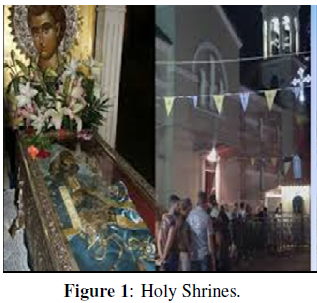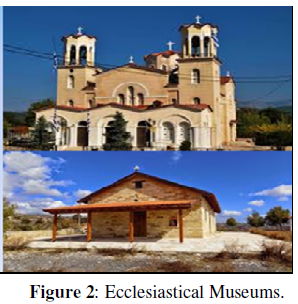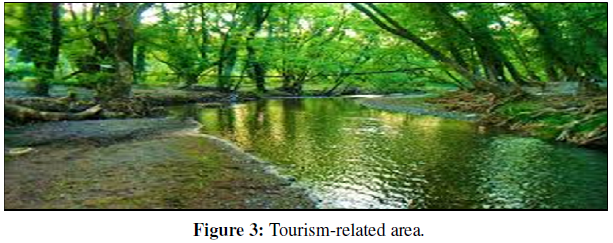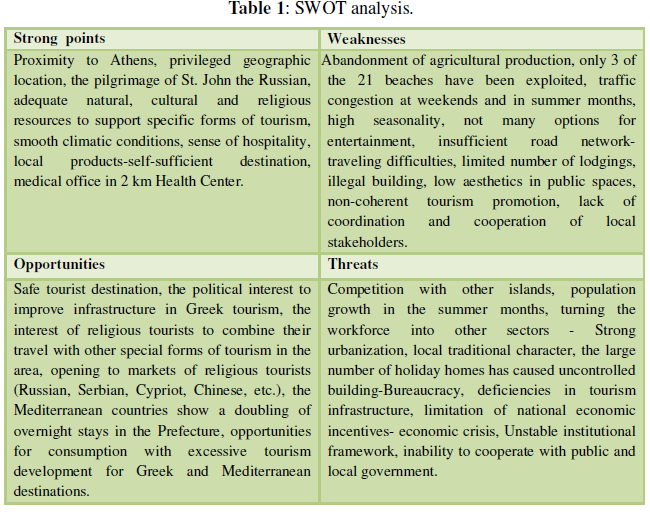Research Article
RELIGIOUS AND PILGRIMAGE TOURISM. THE CASE OF ST. JOHN OF RUSSIAN IN EVIA
4350
Views & Citations3350
Likes & Shares
Religion and spirituality are among the most common motivations for travel and many destinations have become popular as a result of their connections to religiously motivated travelers. Religious tourism can not only contribute to the enrichment of the tourist product of Greece, but also to local development. The development of religious tourism, gains tremendous interest in the present economic circumstances, as it is a factor in strengthening the national economy. The aim of is paper is to exam the prospects for the development of religious tourism in the broader area where the church with the body of St. John the Russian, in northern Evia, Greece, exists. The identified lack of such information and correspondent data in the literature review constitute an inhibitor factor for the further analysis of this topic. In order to tackle the above mentioned issue, we aim- with this paper- to highlight the basic concepts concerning religious and pilgrimage tourism. The pilgrimage of St. John the Russian can be combined with other tourist resources, like nature and culture, and offer a specialized tourist product based on a network of activities. Information was gathered by conducting a survey to guests of the church and to tourist agencies of the area by structured questionnaires and interviews. The results indicate that the opportunities for further development of religious tourism in the area and St. John Russian in the prefecture of Evia can become a contributive factor for this dynamic potential. For achieving this, local key stakeholders - such as community, local authorities, entrepreneurs and church,- must work together. We should point out that this research was carried out for the first time in this area, so there is no data for comparison in the case of St. John the Russian, in northern Evia, Greece.
Keywords: Religious Tourism, Pilgrimage, Special Forms of Tourism, Local Development, St. John the Russian
Religious tourism is a special form of tourism where tourists are motivated partially or exclusively by religious reasons (Rinschede, 1992). (Tomasi, 2002). This article presents the importance of religious tourism as a means of religious, cultural or historical expression in the areas of Greece hosting monuments of religious interest. The ultimate aim of research is to highlight the importance of religious tourism in Evia as a special form of tourism, to analyze the strong points, weaknesses, opportunities and threats and make suggestions for diverse forms of activities of special tourism, contributing to local development. This paper aims to emphasize on the role and significance of the development of special forms of tourism and thus on the diversification of the tourism product. Greece is mostly considered as a sea and sun destination, whereas the potential of special interest tourism can result in a vast variety of tourism offer. Religious tourism is one of the forms that have the potential for further development and this should be taken into account when setting the objectives of an effective all year round tourism policy. Therefore, the scope of this paper is to highlight the fact that the comparative advantages of each area can become the key factors of its diversification in comparison with similar destinations, when a well-defined policy strategy is being drawn and implemented.
LITERATURE REVIEW
Over the past few decades the phenomenon of pilgrimage tourism has been experiencing tremendous changes and is still in the midst of an on-going process of transformation (Noga Collins Kreiner, 2019). Current literature refers to pilgrimage as a holistic phenomenon with religious and secular foundations (Collins Kreiner, 2016).That includes sites that can emerge from both religious and secular contexts. All pilgrims are in a constant quest for a mystical or magical religious experience and these experiences can be described as transformation, enlightenment and life-changing or consciousness-changing events, although words cannot proper describe such experiences (Kim & Kim, 2018; Liutikas, 2015).
According to official figures from the World Religious Tourism Organization, more than 600 million travelers travel each year to visit places of religious interest, (Ncube, & Chikuta, 2020). The total economic benefit from Tourism in Greece is about 17% of Gross National Product (Polyzos, 2017). The main features of religious tourism are that it presents a smooth distribution of visitors throughout the year, with a relative increase in the summer months. It can be a significant tool for boosting regional income and regional development. Its positive contribution to local development was highlighted at the responses of the local stakeholders as well. Also, there is no proper promotion of religious monuments in comparison with the other forms of tourism. (Tsartas, 2010; Collins Kreiner, 2006). It is true that religious tourism in Greece is remarkable due to the intense religious feeling of the Greeks as well as their timeless connection with the Orthodox Christian faith. Numerous Byzantine and post-Byzantine churches, frescoes, icons of immeasurable value constitute the cultural heritage of this country, attracting the interest of pilgrims and religious tourists (Squadron, 2001; Say, 2008). In Greece there are 250 - 280 places of tourist and historical value. From these, 18 have been listed on the World Heritage List of UNESCO (2021). The ideal climatic conditions are an important element of choice as well as the hospitable locals. According to figures from the HATTA Tourists and Travel Agents Association of Greece, 85% of religious tourism, is internal. Data from the Ministry of Foreign Affairs and the Greek National Tourism Organization reveal that 20% - 30% of religious trips are taking place in Christmas, Easter and during religious holidays. In the Prefecture of Evia, there are significant religious-historical monuments and sacred monasteries, 18 Holy Shrines, Byzantine and Ecclesiastical Museums, religious festivals and cultural events, religious congresses, Byzantine and Ecclesiastical Musical Traditions. Also the inherent wood-carving art serves the promotion of religious places of worship (Chantiantoniou & Didaskalou, 2016; Chantiantoniou & Dionysopoulou 2017; Chantiantoniou, 2017). (Figure 1, 2 & 3).






MATERIALS AND METHOD
For the scope of this paper a quantitative research was carried out using structured questionnaires at the level of visitors and distribution channels in a random sample which was supplemented with qualitative research of structured interviews and field observation. We would like to point out that this research was carried out for the first time in this area, so there is no data for comparison in the case of St. John the Russian, in northern Evia, Greece. Structured questionnaires of specific questions with the method of Likert Scale, multiple choice, importance scale, etc. were used. 111 answers were received from visitors, 14 from distribution channels and 11 interviews were conducted with officials of the Pilgrimage, of local authorities in the field of Tourism and businessmen of the region. Our research focused on the visitor profile and their preferences on the time of visit, the duration of their stay, or the combination with other special forms of tourism. Key task was to understand the key motivator factors for visit, to explore the possibilities of synergy with other special forms of tourism and estimate the contribution of Pilgrimage and religious tourism to the development of the region. Issues related to the experience gained by visitors, suggestions for ways of improving the tourist product, as well as identifying opportunities for the development of new tourist products and market segments or tourist offices were examined, aiming to set ways to increase the sales of travel companies specializing in mild and special forms of tourism. The quantitative research structured questionnaires were given to tourism-related visitors and agencies. Key objectives also in this case, among others, were the estimation of the contribution of the pilgrimage and religious tourism to the further development of the region, the identification of the decisive factors of choosing St. John the Russian as a tourist destination and the performance of a SWOT Analysis in order to assess the current situation and define all the necessary future steps for further improvement.
RESULTS AND DISCUSSION
For the purposes of this paper, 150 questionnaires were distributed to a random sample of visitor-tourists who had visited Evia at least once and who were not permanent residents, either electronically or by local distribution and immediate completion in the Pilgrimage area. We used questions of multiple choices according to the Likert Scale method. We analyzed the answers from 111 questionnaires from visitors, 14 from tourist offices and 11 interviews from stakeholders-businessmen in the area and we present them in the following SWOT analysis (Table 1). This SWOT analysis is also used as a tool in determining regional assets and region's relative positioning in “tourist map” of Evia’s prefecture as used as a tool in determining regional assets.


The above SWOT analysis confirms that, St. John Russian in the prefecture of Evia’s is a tourist destination which could contribute to the increasing demand for the tourist product by developing religious tourism. There is a vast range of opportunities that could be taken into account when setting the objectives and mission of the local tourism policy. The research findings are coincident with those of the literature review, according to which religious tourism has not been developed in the region as there was no tourist planning and not specific policy strategies were implemented at regional or national level. (Chantiantoniou & Dionysopoulou, 2017). Besides the SWOT Analysis, we present below the main statistical findings of our research on the visitors’ profile:
According to the gender, 65, 8% of the travelers visiting the place was women, while the 34, 2% was men. The majority of them (24, 3%) belongs at the age group of 25-34 years old.
22, 5% traveled with a group, while 77, 5% of them were individual travelers. 49, 5% has had higher educational studies and was same day visitors. The majority- 47, 7%- organized their trip with the assistance of relative/friends and the main reason of travel- 53, 39%- was for pilgrimage.
1-2 days is the maximum duration of stay at St. John the Russian and most of the visitors chose to stay at rented accommodation (45, 45%). The visitors during their stay combine other activities as well (by 21, 36%, second choice). By the majority key factors for this trip are considered the means of transportation and access- 95,5 %- while the natural resources are among the main satisfactory factors by the travelers- 88,5%-. Coastal tourism is ranked at the first choices of combination among all the special forms of tourism offered at this area. The majority of the travelers is willing to propose this destination to friends and relatives. While the natural and religious resources are the strengths of this destination, the infrastructure, the access are considered strong weaknesses. Therefore the improvement of the means of transportation would contribute in a very positive way to the development of this destination. The results of the questionnaires sent to distribution channels vary. 70% of them belong to the age group of 41-70 years old and 80% travel with a group. The 64, 3% visits St. John the Russian on pilgrimage reasons because of the uniqueness of the monument and they combine the visit with cultural activities as well. The majority is same day visitors and is willing to propose the destination to relatives and friends. In this case the relation between price and quality is considered as the major strength of this destination, whereas the access is its strongest weakness.
CONCLUSION
As already mentioned, this research was carried out for the first time in this area, so there is no data for comparison in the case of St. John the Russian, in northern Evia, Greece. Nevertheless the development of a strategic approach for religious and pilgrimage tourism can be built on the comparative advantages of our country on this specific field by creating new tourist sites to attract tourists with intellectual pursuits and special interests. Thus, for the better use and balanced development of religious tourism in the region, it is necessary to set up an organized tourism policy framework based on the hierarchy of development priorities and the use of appropriate means of implementation (Briassouli, 2000). The basic prerequisite for the sustainable development of religious tourism in the region and in combination with other special forms is the undertaking of coordinated actions by all the actors and organizations of the public and private sector, the acceptance and participation of the Church and the local community in any activities, to become a place of special tourist interest. The following proposals are the outcome of our research and refer to policy measures aiming at an efficient and responsible tourism plan of the region.
The comparative advantages of the area should be turned into competitive ones always with respect to the environment, its customs and tradition. Sine qua non condition is the cooperation of all local, public and private tourism stakeholders. Specific promotional actions should be developed and implemented aiming at international emerging markets or markets of co-religious countries. This could be achieved by creating the correspondent advertising promo material. The creation of special packages for religious tourism trips could be one of them, resulting in the extension of the duration of stay "On the Paths of the pilgrimages of Evia". Key task should be the upgrade the quality of accommodation in order to improve the level of satisfaction of the tourists and in overall to enhance the competitiveness of the services provided. Tourism policy interventions should focus on a specialized marketing plan of the area, on a Market research and study recording demand and trends. The cooperation with specialized TOs should be strengthened. In particular, for the St. John of Russia area, the strategic approach should include activating the state mechanism to improve infrastructure for safer and faster access to the area, the creation of cultural centers, with concerted actions to attract Greek or foreign investors. Of course more investments should be made not only on infrastructure but on the education and skills of the human capital. Last but not least the connection with the Orthodox and Catholic Theological Schools and Institutes of the Greek Diaspora and the organization of theological seminars, conferences, festivals, religious and cultural events could be a contributive factor for this task.
Besides, the emotions, communication and social ties that the tourist can develop with the local community and the tourism enterprises are the ones that will differentiate the destination and will entangle the tourists with the region (Sigala & Christou, 2014; Dereoglou, 2020; Sklirou, 2020; Vagionis & Skoultsos, 2017; konsolas, 2020). The most important outcome of our research refers to the strengthening of the collaboration of all the major stakeholders of the area, since only through the procedure of consensus determinant steps and measures can be taken in order to measure up to the challenges of a constant tourism environment.
DISSERTATION AKNOWLEDGEMENT
We wish to thank Ms. Eftychia Christina Aivaliotou, Alternate Director of Statistics Dept. Ministry of Tourism of Greece for her kind contribution.
Nomenclature
St: Saint
- Briassouli, E. (2000). Tourism Development Planning Characteristic Approaches to Tourism Development MultiScientific Approaches 123-148.
- Chantiantoniou, A. (2017). Study Religious tourism in Greece. https://etravelnews.gr/meleti-o-thriskeutikos-tourismos-stin-ellada/
- Chantiantoniou, A., & Dionysopoulou, P. (2017). The religious tourism in Greece Case study of Saint John Russian in N Evia. Journal of Tourism, Heritage & Services Marketing 3(2), 15-24.
- Chantiantoniou, A., & Didaskalou, E. (2018). Tourism, religious faith and pilgrimage travel. The case of St. John of Russian in the prefecture of Evia International Conference on Business & Economics of the Hellenic Open University.
- Christou, E. (1999). Tourism Market Research. Athens Inter books 63.
- Collins Kreiner, N. (2006). Christian tourism to the Holy Land pilgrimage during security crisis England Ash gate Publishing Limite 1, 7.
- Collins-Kreiner, N. (2010). Researching pilgrimage continuity and transformations. Annals of Tourism Research 37(2), 440-456.
- Dereoglou, E. (2020). Prospects for the development of religious tourism in Lefkada. Available online at: https://hellanicus.lib.aegean.gr/bitstream/handle/11610/21368/Derezoglou%20Eleni_Thesis.pdf?sequence=1&isAllowed=y
- Kim, B., & Kim, S. (2018). Hierarchical value map of religious tourists visiting the vatican city rome Tourism Geographies, 1-22.
- Konsolas, M. (2020). The development of religious tourism at the center of the meeting with the Metropolitan of Rhodes Mr Kyrillos. https://www.konsolas.gr/anaptyxh-thriskeftikou-tourismou-dwdekanhsa-synanthsh-konsola-kyrilloy/
- Liutikas, D. (2015). In search of miracles: pilgrimage to the miraculous places. Tourism Review, 70(3), 197-213.
- Ncube, N., & Chikuta, O. (2020). Perceived Economic Impact of Religious Tourism. The Case of Zimbabwe.
- CollinsKreiner, N. (2019). Pilgrimage tourism-past, present and future rejuvenation a perspective article.
- Polyzos, S. (2017). The spatial and economic dimension of religious tourism in Greece. Research Paper Series, 23(1), 1-48.
- Rinschede, G. (1992). Forms of Religious Tourism. Annals of Tourism Research, 19, 54.
- Say, P. (2008). The Parameters of Religion in Cultural Tourism Purchase without Borders, 13.
- Sigala & Christou (2014). Social computing in travel tourism and hospitality. Available online at: https://www.hba.gr/5Ekdosis/UplPDFs/sylltomos14/191-206%20Sigala%202014.pdf
- Sklirou, E. (2020). Opportunities and prospects for the development of religious tourism. Available online at: https://apothesis.eap.gr/handle/repo/37269
- Squadron, P. (2001). From the Pilgrim to the Religious Tourist. Sociological Approach. Available online at: http://traveldailynews.gr/hypostyles/article/702
- Tomasi, L. (2002). Homo Viator from Pilgrimage to Religious Tourism via the Journey In WH Swatos Jr and L Tomasi From Medieval Pilgrimage to Religious Tourism the Social and Cultural Economics of Piety Westport Connecticut Praeger ΒΑΝΚ ltd 1-24.
- Tsartas, P. (2010). Greek Tourism Development Characteristic Investigators Suggestions. Athens Kritiki.
- UNESCO (2021). The world cultural heritage list. Available online at: https://whc.unesco.org/en/list/
- Vagionis & Skoultsos (2017). KEPE study on cultural and religious tourism. Available online at: https://www.tour-market.gr/%/





